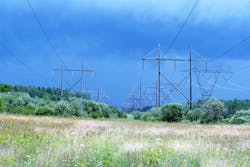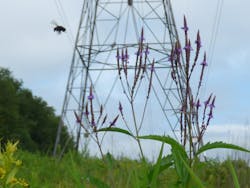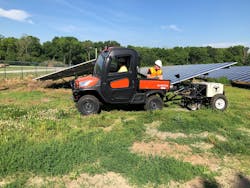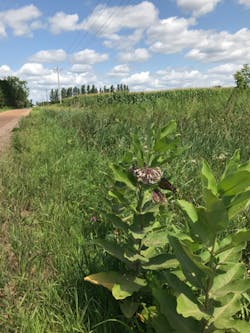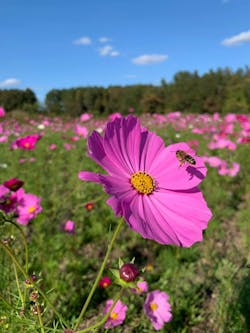Charging Ahead with Monarch Butterfly Conservation
The iconic monarch butterfly continues to make headlines. In December 2020, the U.S. Fish & Wildlife Service (USFWS) announced that the monarch butterfly was warranted for listing under the Endangered Species Act but precluded (or delayed) due to higher priority needs. In early January, the Center for Biological Diversity filed a notice of intent to sue the USFWS for delaying the listing of 11 species, including the monarch butterfly. That same month, transition priorities put forth by the new White House administration included a review of the previous administration’s monarch listing decision.
Following these announcements, the 2020-2021 overwintering numbers for both the Western and Eastern monarch butterfly populations were released. The Western population dipped to a catastrophic new low: less than 2000 butterflies lived along the California coast, representing a 99.9% reduction from historic levels. The Eastern population, which overwinters in central Mexico, fell an additional 26% from the previous year, representing only about one-third of the estimated target to maintain a stable population.
Concerns around the monarch butterfly are dynamic and rapidly changing. Many utilities are watching these changes closely, weighing what it means and how it might affect their operations.
The Generation Phase: A Collaborative Approach
In late 2017, a group of energy companies and state departments of transportation in the Rights-of-Way as Habitat Working Group launched an unprecedented effort to conserve the monarch butterfly in the face of sharp population declines, while also addressing their concerns about the potential regulatory impacts of a threatened or endangered listing. Over the course of two years, more than 45 energy and transportation organizations — working closely with the USFWS, the University of Illinois Chicago (UIC), consultants, and conservation organizations — created a conservation agreement unlike any before. It was the first-ever nationwide Candidate Conservation Agreement with Assurances (CCAA).
CCAAs are voluntary agreements between non-federal landowners or land managers and the USFWS in which conservation measures are adopted for at-risk species, like the monarch butterfly, prior to becoming listed as threatened or endangered. In turn, the USFWS provides assurances that they will not be required to implement additional conservation measures beyond those in the agreement, even if the species is listed.
In April 2020, the CCAA for the monarch butterfly was approved by the USFWS for energy companies and transportation agencies operating across the lower 48 U.S. states. The agreement was recognized by conservation groups, industry partners and the USFWS for its innovative approach and significance in terms of sheer scale and cross-sector collaboration. Former USFWS Director, Aurelia Skipwith, said in a press release that, “This agreement is a huge boost for the conservation of monarch butterflies and other pollinators on a landscape scale,” adding that it will “provide regulatory certainty for industry while addressing the conservation needs of our most at-risk species.”
The T&D Phase: Building Voluntary Conservation
During the first year of CCAA implementation, UIC, which serves as the program administrator, received 25 applications from energy companies and transportation agencies across the United States. Collectively, these organizations committed to adopting conservation actions to support monarch butterflies on about 750,000 acres, including on transmission and distribution corridors, solar farms, roadsides and other facilities. As the CCAA enters its second year, we asked a few of the enrolled energy companies and prospective applicants to reflect on the monarch butterfly listing decision, the CCAA, and what it means for their business.
Reactions to the USFWS’ listing decision in December 2020 ranged from surprise to indifference. For many of the companies already enrolled in the CCAA, the decision was perceived as essentially a “non-event” given the regulatory certainty they already receive through the agreement. For most, it reinforced their previous decision to enroll.
“The listing decision has not changed our opinion on the importance of enrolling in the CCAA, if anything it has strengthened it,” said Alicia Kroll, member account analyst lead, at East Central Energy (ECE). ECE, which operates in Minnesota and Wisconsin, was one of the first applicants and also the first rural electric cooperative to enroll in the CCAA. “It is highly likely the monarch will be listed as endangered in the future and the CCAA provides us with an assurance our business operations will not be affected.”
While the USFWS’ listing decision provides extra time for companies to enroll in the CCAA before an effective listing date, momentum within the industry has remained high.
“We are moving forward with the same dedication to pollinators and pollinator habitat,” said Will Ricks, senior environmental scientist, at Duke Energy, which submitted its application in early 2021 and plans to enroll its entire transmission and distribution system across six states. “Duke Energy has been a partner of the Monarch CCAA since the beginning and the listing decision did not impact our participation.”
Industry CollaborationThe unique cross-sector collaboration between organizations across the energy and transportation sectors provides opportunities to learn from each other and share best practices related to vegetation management and habitat conservation. Evergy was also one of the first utilities at the CCAA development table, given its long-standing conservation and restoration programs on native grasslands in Kansas and Missouri.
Eric Johnson, senior environmental consultant at Evergy, noted, “The collaborative nature of this effort allowed us to benefit from the expertise, experience, and knowledge of everyone involved. This way, we did not have to go it alone and solve all the problems on our own. I think [the CCAA] is important because it is a cost-effective way for companies to collaborate and reduce future regulatory uncertainties and work across service areas on a shared goal to maintain and enhance habitat for the monarch.”
In addition, the close coordination with the USFWS throughout the development of the CCAA changed the typical dynamic between “regulator” and “regulated” to one of collaboration.
“I believe that this movement has shown that organizations that manage habitat on rights of way are not the big, bad companies with scorched earth programs,” said Lew Payne, manager ROW/Environmental, at New York Power Authority (NYPA). “We came together as an organization to help identify [and] share information and validate that we all manage and protect biodiverse rich habitat along a multitude of rights-of-way corridors. With this effort, I believe the regulatory agencies saw this movement, how we manage these lands, and changed their perspective of our organizations.”
Ricks added, “We felt it was important to be a partner from the onset of the Monarch CCAA, so we could best support our agency partners and learn the best management practices from other leading utilities.”
On Deciding to EnrollNiSource, which operates gas transmission and distribution lines across six states in the central and northeastern United States. as well as electric transmission, distribution, and generation in Indiana, recognized that creating or enhancing habitat for a potentially threatened or endangered species could present a significant regulatory risk.
“ROWs provide some of the most important migratory pathways from central Mexico to northern breeding grounds in the United States,” said Steve Barker, environmental principal at NiSource. “It is imperative for rights-of-way managers to manage for habitat suitability and not be penalized for it.”
The ultimate goal of any CCAA is to demonstrate that sufficient voluntary conservation is occurring, thereby avoiding the need to list the target species. Since the monarch butterfly has been determined to be “warranted but precluded” for listing, the USFWS will continue to consider conservation commitments made by energy companies and transportation agencies under the CCAA as part of their regular reviews of the listing status.
“The CCAA provides a pathway to first help prevent the listing, but then if a listing occurs, it provides incidental take coverage,” Barker said.
The regulatory assurances and “operational flexibility” provided by the CCAA are most often cited as the biggest benefits of enrollment. As Kroll described it, the CCAA puts organizations “in the driver’s seat” to determine which conservation measures to implement on their system, along with where and how. All the companies we spoke to indicated that many of the conservation measures spelled out in the CCAA were already implemented to some degree on their systems prior to enrolling in the agreement, particularly where they have robust Integrated Vegetation Management (IVM) programs. “This really feels like the responsible thing to do,” Payne said. “It makes more sense to get credit or assurances for the good practices that we already have in place.”
For early CCAA applicants, the benefits of enrolling outweighed any associated costs. Some referred to it as an “investment” to avoid potential compliance costs in the future; others considered it an extension of their existing vegetation management programs and sustainability initiatives.
“[The CCAA] gives your organization the chance to showcase your environmental stewardship to customers, members and the public, and help not just the monarch, but many species that are at risk due to loss of habitat,” said Kroll.
First Year ImplementationFor many of the enrolled organizations, the biggest learning curve during the first year of implementation was identifying and tracking the extent of suitable habitat on their systems.
As it considered the CCAA requirements, NYPA relied on data collected as part of its long-range, system-wide management plan.
“We began mapping milkweed populations about six years ago when the monarch threat hit our radar,” Payne said. “This was before we heard about the CCAA. Once we did, we were able to review, adapt and put a few measures in place to ensure that we would easily fall within the guidelines.”
Duke Energy also relied on its own large-scale mapping program, which combines natural resources information on its ROWs and other facilities to support environmental compliance. However, not all companies have such widespread mapping programs in place. Evergy used land cover datasets to estimate suitable habitat, which it believes may actually underestimate the total amount of habitat on its ROWs and company-owned lands. It has also worked with existing staff and processes to find ways of making conservation measures, monitoring and tracking feasible.
Kroll agreed by saying, “We realized that being involved in the CCAA doesn’t have to fall on just one person or department. Think outside the box, and maybe you can find someone in your company who has a passion for the environment or wildlife that can help get some of the work done.”
Similarly, NiSource found that using planners, who are already deployed on its system as part of its IVM program, to conduct monitoring activities made the costs associated with this requirement essentially negligible.
Johnson added, “As with any new effort, the initial monitoring, tracking, and reporting can be inefficient; and that was the case for us as well. However, I don’t expect our second year to be as difficult now that we know what data and processes are needed and what we can do to be more efficient. Also, because of this collaborative effort, new tools and reporting processes will likely be developed in the future to make the tracking and reporting requirement even more efficient.”
UIC maintains an online resources library and the “Monarch CCAA Toolkit” on its website, which contains everything from the CCAA application materials to monitoring and reporting templates, guidance documents and video tutorials. Applicants and enrolled organizations have also found the monthly meetings and case study presentations from their peers helpful to compare approaches and work together to overcome challenges.
Lights On: Illuminating a Path for Conservation The Next Four Years
The Next Four Years
Last year’s decision by the USFWS specified the deadline for the proposed listing rule for the monarch butterfly as fiscal year 2024. In the interim, the USFWS will conduct annual reviews of the population status. Based on these reviews, it may decide to re-prioritize listing or invoke emergency listing procedures. Following the proposed listing rule, the final rule and effective listing date will follow about 12 months afterwards. Energy companies and transportation organizations will be eligible to enroll in the CCAA up until the effective listing date, so long as the enrollment cap for the agreement is not exceeded before then.
The Future of CCAAs
As the first voluntary agreement of this scale, the monarch butterfly CCAA can serve as a model for other conservation efforts. There is strong interest among industry partners, agencies, and conservation groups to expand this concept to other species and move towards a landscape-level approach.
“In the last 100 years, the United States has seen a dramatic decline in open grass and forb-dominate habitat,” Ricks said. “With this landscape level change, ROWs are some of the few remaining open areas that can support this habitat type and therefore it is important we manage them to the best of our ability.”
The other utilities we spoke to, and many others, agree that stepping up to this challenge and finding ways to continue and expand their stewardship activities, while also safely and reliably meeting their customers’ needs, is the future. CCAAs provide one such path. Through each conservation commitment, we illuminate a new path for monarch butterflies and other pollinators that helps sustain the landscapes we all rely on.
Editor’s Note: If you are interested in learning more about the CCAA, please visit: http://rightofway.erc.uic.edu/national-monarch-ccaa/. In addition to more specifics about how the CCAA works, you can also find out which organizations have enrolled and how to apply.
Caroline Hernandez is program coordinator - sustainable landscapes at the Energy Resources Center at the University of Illinois Chicago. She supports the Rights-of-Way as Habitat Working Group and other efforts to engage energy and transportation leaders in pollinator habitat creation and conservation. She holds a dual master’s degree in international relations and natural resources and sustainable development from American University and has a background in globalization and climate change.
Dan Salas is a senior ecologist with Cardno where he advises and supports pollinator conservation, planning, and other ecological projects. He supported UIC and partners in development of the Monarch CCAA and other Rights-of-Way as Habitat Working Group efforts.
Iris Caldwell is program manager – sustainable landscapes at the Energy Resources Center located at the University of Illinois Chicago. She facilitates the Rights-of-Way as Habitat Working Group, the Illinois Monarch Project and other efforts to engage industries in pollinator habitat conservation. Her background is in environmental regulatory compliance, greenhouse gas accounting, carbon offset project verification and other environmental and sustainability reporting.
About the Author
Iris Caldwell
Iris Caldwell, P.E., is program manager – Sustainable Landscapes at the Energy Resources Center at the University of Illinois-Chicago. She facilitates the Rights-of-Way as Habitat Working Group, the Illinois Monarch Project, and other efforts to engage industries in pollinator habitat conservation. She also serves on the Right-of-Way Stewardship Council. She holds a degree in civil – environmental engineering from Iowa State University and has a background in environmental regulatory compliance, greenhouse gas accounting, and sustainability reporting.
Caroline Hernandez
Caroline Hernandez ([email protected]) is program coordinator - sustainable landscapes at the Energy Resources Center at the University of Illinois Chicago. Caroline supports the Rights-of-Way as Habitat Working Group and other efforts to engage energy and transportation leaders in pollinator habitat creation and conservation. Caroline holds a dual master's degree in international relations and natural resources and sustainable development from American University and has a background in globalization and climate change.
Dan Salas
Dan Salas ([email protected]) is a senior ecologist with Cardno where he advises and supports pollinator conservation, planning, and other ecological projects. Dan supported UIC and partners in development of the Monarch CCAA and other Rights-of-Way as Habitat Working Group efforts.




